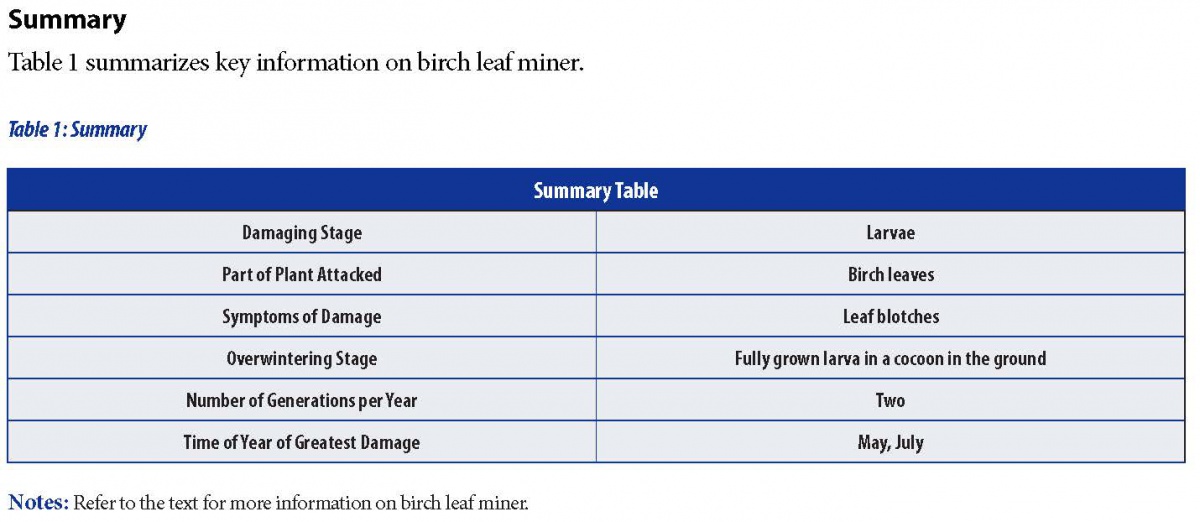The birch leaf miner (Fenusa pusilla) feeds primarily upon three host plants: gray birch, paper birch, and European white birch. This European native was introduced into the U.S. pre-1923 and has grown to economic levels as one of the most important nursery insect pests of New Hampshire.

Bugwood.org.
Description
In its damaging stage, the birch leaf miner larva is translucent white, flattened, and about 2/10" long. Several black spots can be found on the underside of its thorax, which is the part of the body where legs attach to. A black spot is also found on the first segment of its abdomen. The adults are small black wasp-like insects about 1/8” long.
Life Cycle
Buried 1”- 2” deep in the soil, the birch leaf miner overwinters as a full-grown larva encircled by a cocoon. In May, the larva pupates, and the adult emerges in 8-15 days. After mating, the female lays several hundred eggs in developing birch leaves. In 6-10 days, the eggs hatch (1-20 eggs per leaf). The young larva then mines between the lower and upper surfaces of the leaf. There are two generations of the birch leaf miner per year in New Hampshire.
Feeding by the young larvae eventually causes large blotches, wilting, and gradual leaf death, which reduces the photosynthetic abilities of the tree itself. It weakens the tree and causes it to be less vigorous and more susceptible to invasion by other insects and diseases. In the 1960’s through 80’s, it was common to see severe damage, which was sometimes fatal to the tree. Now, imported parasites keep this pest under control.
Management
Birch leaf miners prefer sunny areas but can attack susceptible trees almost anywhere. Birches tolerate leaf miner attacks best when they are planted in areas that are shady, cool, and moist. Formerly, attacks could seriously weaken trees, so good fertility and horticultural care were necessary.
IPM Strategies:
- Cultural - For trees already established, keep the soil in good condition by adding organic matter and fertilizer as needed. Keep the trees properly watered during prolonged periods of dry weather. if you have an unacceptable amount of leaf damage, look for species of birch that are resistant to birch leaf miner attacks.
- Monitoring - The first generation of birch leaf miner is the most damaging and can be seen emerging in mid-May. Managing adults is important in breaking the cycle of infestation. Once larvae are in the foliage, management becomes much more difficult. Using yellow sticky cards placed in host trees can help monitor for adults.
- Biological Control - A few parasitic wasp species have been released in North America, and two ichneumond wasps, Lathrolestes nigricollis and Grypocentrus albipes are present in the Northeast. They are so effective, significant leaf injury is now difficult to find in New Hampshire.
- Chemical Control - Chemical controls are no longer necessary for this pest in New Hampshire.

Colorado State University, Bugwood.org.

Colorado State University, Bugwood.org.
 Stop! Read the label on every pesticide container each time before using the material. Pesticides must be applied only as directed on the label to be in compliance with the law. All pesticides listed in this publication are contingent upon continued registration. Contact the Division of Pesticide Control at (603) 271-3550 to check registration status. Dispose of empty containers safely, according to New Hampshire regulations.
Stop! Read the label on every pesticide container each time before using the material. Pesticides must be applied only as directed on the label to be in compliance with the law. All pesticides listed in this publication are contingent upon continued registration. Contact the Division of Pesticide Control at (603) 271-3550 to check registration status. Dispose of empty containers safely, according to New Hampshire regulations.
Download the resource for the complete factsheet.
